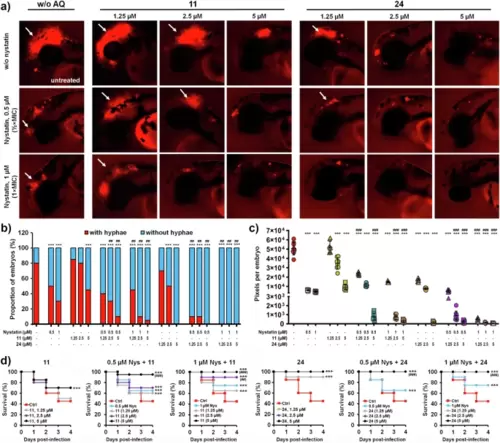Fig. 5
- ID
- ZDB-FIG-250117-28
- Publication
- Pavic et al., 2024 - Long-chain 4-aminoquinolines inhibit filamentation and increase efficacy of nystatin against Candida albicans infections in vivo
- Other Figures
- All Figure Page
- Back to All Figure Page
|
Combination treatment with nystatin and 11 or 24 is more effective than individual treatments in the zebrafish model of disseminated candidiasis.a Filamentation of C. albicans M137 expressing RFP at 24 h post-treatment (hpt). b Proportion of embryos with/without visible hyphae in the hindbrain at 24 hpt, assessed by fluorescence microscopy (n = 20 embryos in each group). c Dose-dependent effect of nystatin, 4-AQ (11 and 24) and their combinations on the progress of C. albicans infection. Each data point represents the integrated red fluorescence intensity of a single alive zebrafish embryo at 24 hpt, and the signal in each group (8 embryos) is expressed as mean ± SD. Statistical significance was determined by χ2 test by comparing the distribution of embryos with/without hyphae in the control (DMSO-treated) and treated groups (*** P ≤ 0.001) as well as in the groups receiving nystatin and combination treatments (## P ≤ 0.01). Also, one-way ANOVA with the Bonferroni test was used to determine statistical significance by comparing fluorescence signal of the control (DMSO-treated) sample with each treated group (*** P ≤ 0.001), as well as between the nystatin-treated and the corresponding combination-treated group (## P ≤ 0.01). d the survival of the infected embryos treated with nystatin, 4-AQ and their combination compared to DMSO-treated embryos (control), as represented by Kaplan-Meier curve. Statistically significant differences in the survival between the treated and untreated groups (## P ≤ 0.01), as well as between the nystatin-treated groups with the corresponding combination treatment groups (## P ≤ 0.01) were determined using a log rank (Mantel-Cox) test. |

